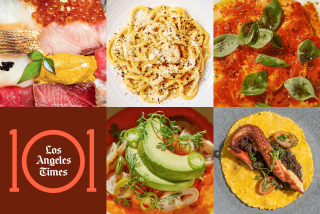Consumers raise cane over corn sweetener
You can spot Dawn Wynne at the grocery store. She’s one of those conscientious label readers busy studying cans, bottles and jars in aisle after aisle.
But it’s not calories, sodium or preservatives she is looking for. She is on patrol for high fructose corn syrup; it’s an unadvertised part of sauces, cereal, candy and especially soda, and she wants none of it.
The Redondo Beach resident looks for foods sweetened with “pure cane sugar, honey or fruit juice.” Wynne believes “they are healthier and break down in the body more easily.”
Consumers -- at the grocery store and restaurants -- are increasingly demanding sodas and other products sweetened with sugar, not corn syrup.
The trend is so strong that the Corn Refiners Assn. has launched a major marketing campaign and Internet site, www.sweetsurprise.com, to defend the sweetener. They are battling signs like the one saying, “Get Real! . . . No High Fructose Corn Syrup” that faced the parking lot at the Jamba Juice shop in Seal Beach on Thursday.
High fructose corn syrup has become a favorite target of the health-conscious as an alleged cause of America’s obesity boom. A typical 2-liter bottle of soda contains 15 ounces of corn syrup, according to the U.S. Department of Agriculture. Whether it’s really at fault is open to debate.
The Corn Refiners Assn. contends that high fructose corn syrup is just as natural as table sugar and honey. Others say it’s not natural at all, because it is manufactured through a chemical process and does not occur in nature by itself. The Center for Science in the Public Interest called the corn refiners’ campaign “deceptive.”
Most medical research says it is the calories, rather than the sweetener, that make a difference to a person’s health. And sugar and high fructose corn syrup have identical calorie counts.
“Our message is that people should cut down on both,” said CSPI Director Michael Jacobson. Likewise, the American Dental Assn. says sugar is equally bad for teeth regardless of whether it comes from corn or cane.
The Corn Refiners Assn. is reacting to a steady slide in sales of high fructose corn sweetener.
“We have been very concerned about the misunderstanding of our product in the marketplace and want to provide the facts so that consumers can make their choices based on science rather than urban myth. HFCS and sugar are treated by the body the same, they contain the same calories, and nutritionally are no different,” said Audrae Erickson, president of the Corn Refiners Assn.
Even so, so many consumers have become wary of corn sweeteners that smaller drink makers such as Hansen, Jones and Thomas Kemper have reformulated their sodas to use cane sugar.
Taco Bell and other fast-food chains have added sugar-sweetened beverages as alternatives to their corn sweetener-laden soft drink menu.
Meanwhile, U.S. sales of Coca-Cola Classic made with corn sweetener fell 5.5% last year, according to the Beverage Industry 2008 Soft Drink Report. Sprite dropped 9.2%, Pepsi-Cola was down 8.9% and Mountain Dew declined 3.1%
The growing popularity of bottled water and other drinks is one reason for the decline of sweet carbonated drinks. But shoppers say drinks made with sugar cane just taste better.
“It has a crisper flavor, not as cloying. I think it is a better-flavored drink,” said Charlie Howell, who periodically finds cane-sugar-sweetened Coca-Cola imported from Mexico at the Costco in the Los Feliz neighborhood of Los Angeles.
The shift in consumer taste and uncertainty about high fructose corn sweetener is apparent to John Nese, owner of the Galco’s Soda Pop Shop, a 10,000-square-foot soft drink emporium in Highland Park. “Our sales are up 20%.”
“There’s just a lot more awareness about high fructose corn syrup among the public, and once people taste a soda flavored with cane sugar they like it better,” he said.
Nese sells 500 different soft drinks, including cane-sugar Coca-Cola, Dad’s root beer and Nesbitt’s orange soda, an 80-year-old Los Angeles brand.
His Coke comes from Mexico through a third-party supplier. Mexican bottlers still use cane sugar because the crop is plentiful in Latin America. They also do not have to contend with U.S. trade barriers that drive up the price of cane sugar imports.
Soda makers are also reacting to the trend. Hansen abandoned corn syrup last year, when a third of the calls to its customer service center were from consumers objecting to the sweetener, said Gregg Arends, vice president of marketing for Corona-based Hansen Natural Corp. Natural foods retailers had complained about the same issue for years, and some threatened “to kick Hansen’s out,” Arends said.
It took the beverage company the better part of a year to make the switch because of the difficulty in reformulating the drinks to maintain the same flavor profiles. It’s only been in the last few months that the cane sugar soda has been widely distributed.
Most research about the nation’s collective fatness blames calorie intake and couch potato sloth, rather than any sweetener.
Some scientific research points to adverse health effects from fructose, a type of sugar that makes up 55% of the sweetener in soft drinks with corn syrup. Although chemically different, cane sugar is half-fructose.
Whether that extra shot of fructose is any worse than identically caloric soda pop made with cane sugar isn’t clear, said Dr. Peter Havel, a UC Davis nutrition expert who is launching a National Institutes of Health study that will look at the effects of fructose.
“This is really an area that needs further study,” Havel said.
Still, angst over high fructose corn syrup has taken a toll on the business.
Annual per-capita consumption of the sweetener in the United States peaked at 63.7 pounds in 1999. But it has dropped steadily since then and stood at 56.3 pounds in 2007, 12% off its peak. That’s the lowest consumption level since 1994.
Cane sugar consumption also has dropped during the period, but by a smaller 6% and now is at 62.1 pounds.
Beverage makers started the switch to high fructose corn syrup in the 1980s because it’s less expensive than sugar, decays less quickly, and is easier to transport and mix into formulas. Even with the recent increase in corn prices, it is still less expensive to use corn syrup than sugar.
The big beverage makers aren’t likely to spend money on retooling to go back to sugar, said beverage consultant Tom Pirko.
Some shoppers say they don’t want to consume the sweetener but don’t have time to worry about it.
“I’m aware that edibles would be healthier -- and probably taste more natural -- without the addition of corn syrup or that high fructose junk,” said Michele Mooney of Van Nuys.
“But I don’t look for that ingredient when I purchase foods mostly because the labels are too long, the ingredients too numerous, the print too small and the chemicals too frightening.”
--
More to Read
Eat your way across L.A.
Get our weekly Tasting Notes newsletter for reviews, news and more.
You may occasionally receive promotional content from the Los Angeles Times.







